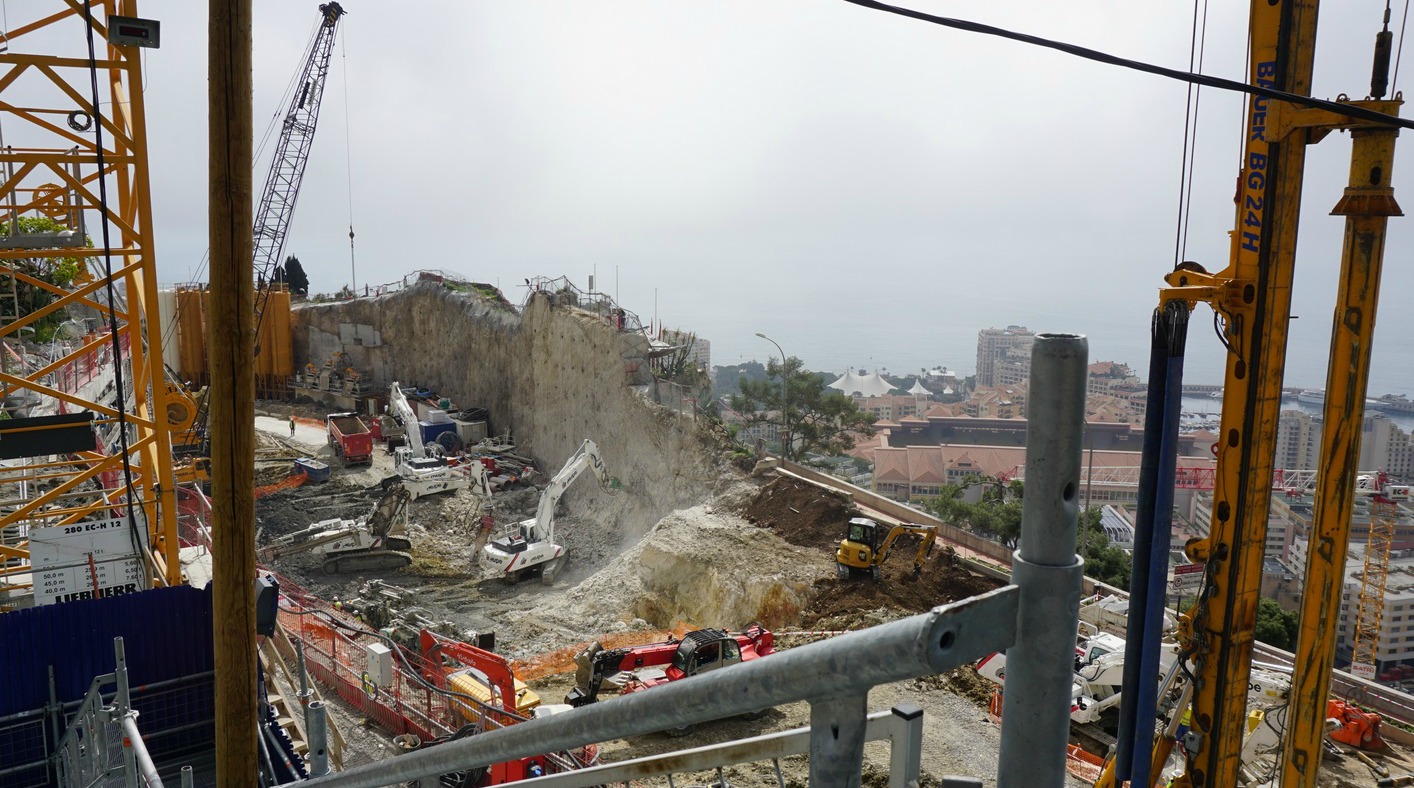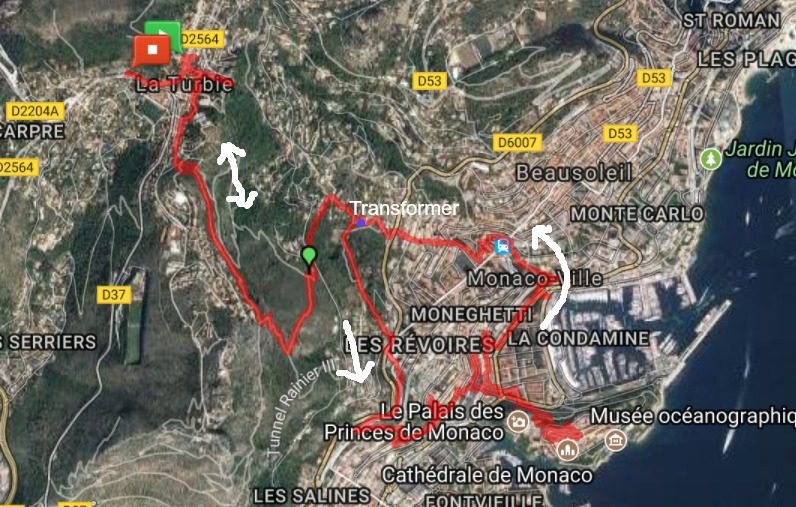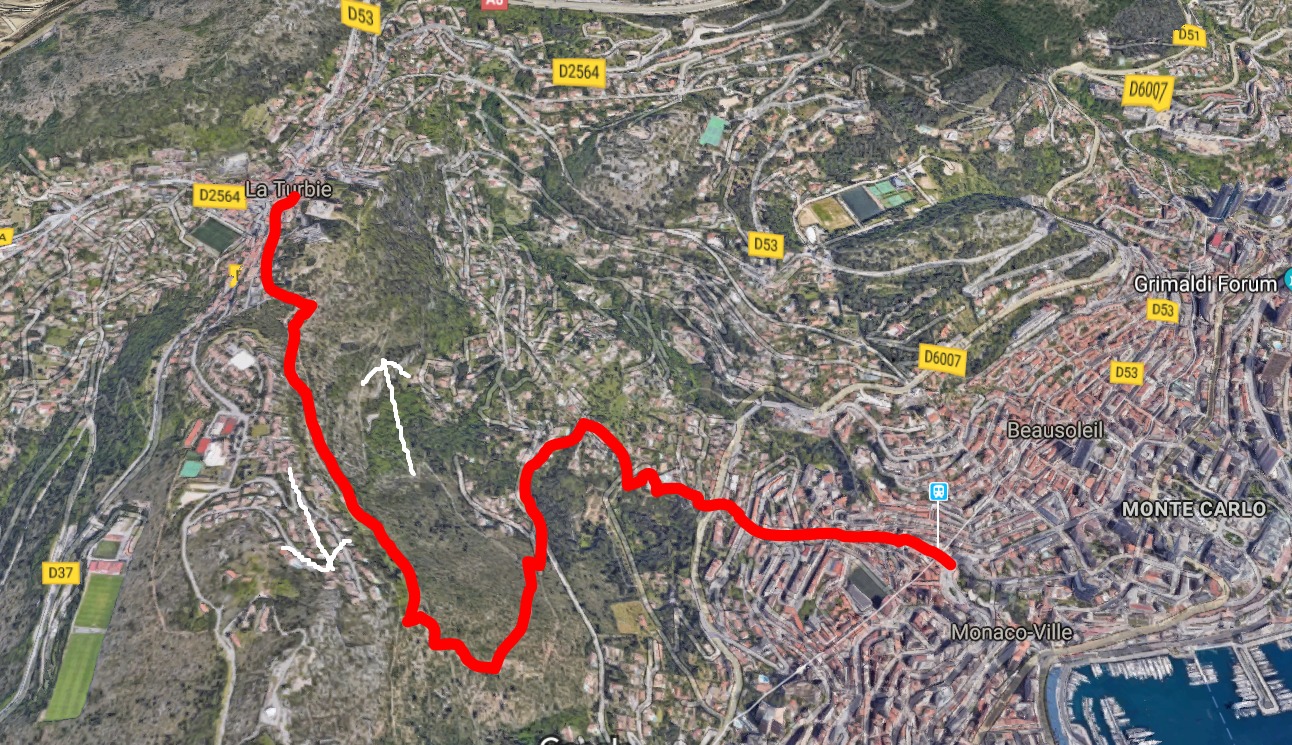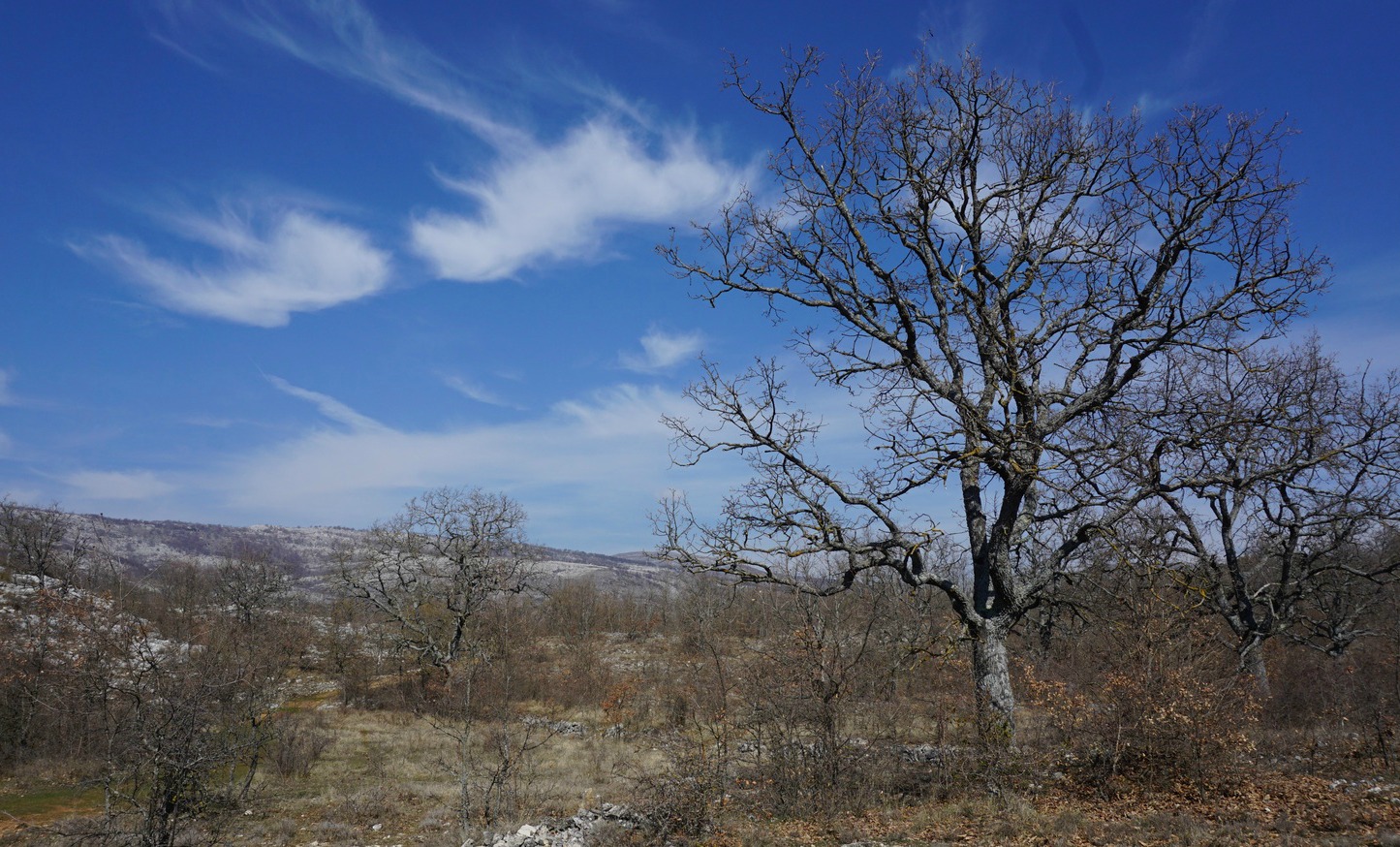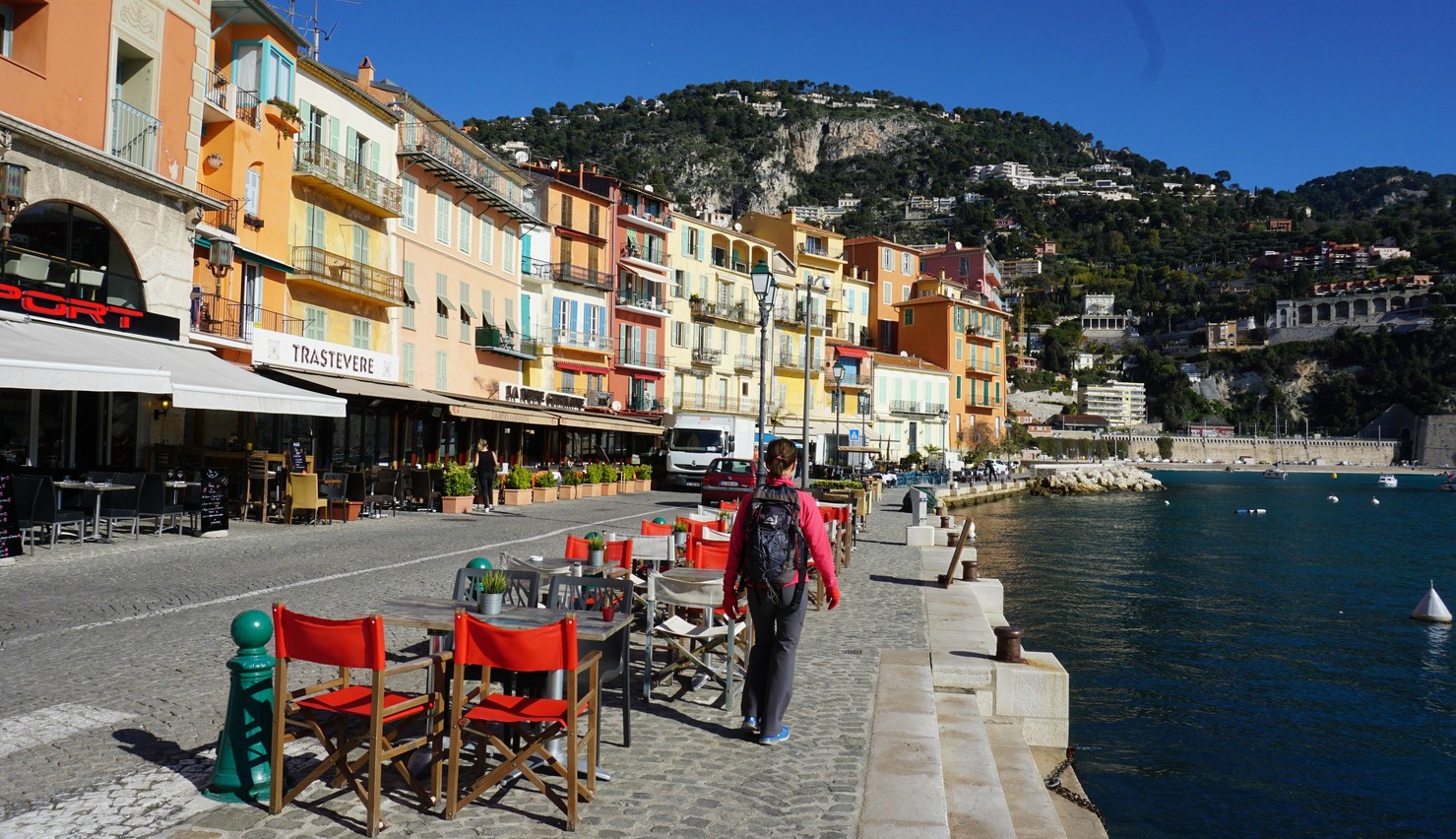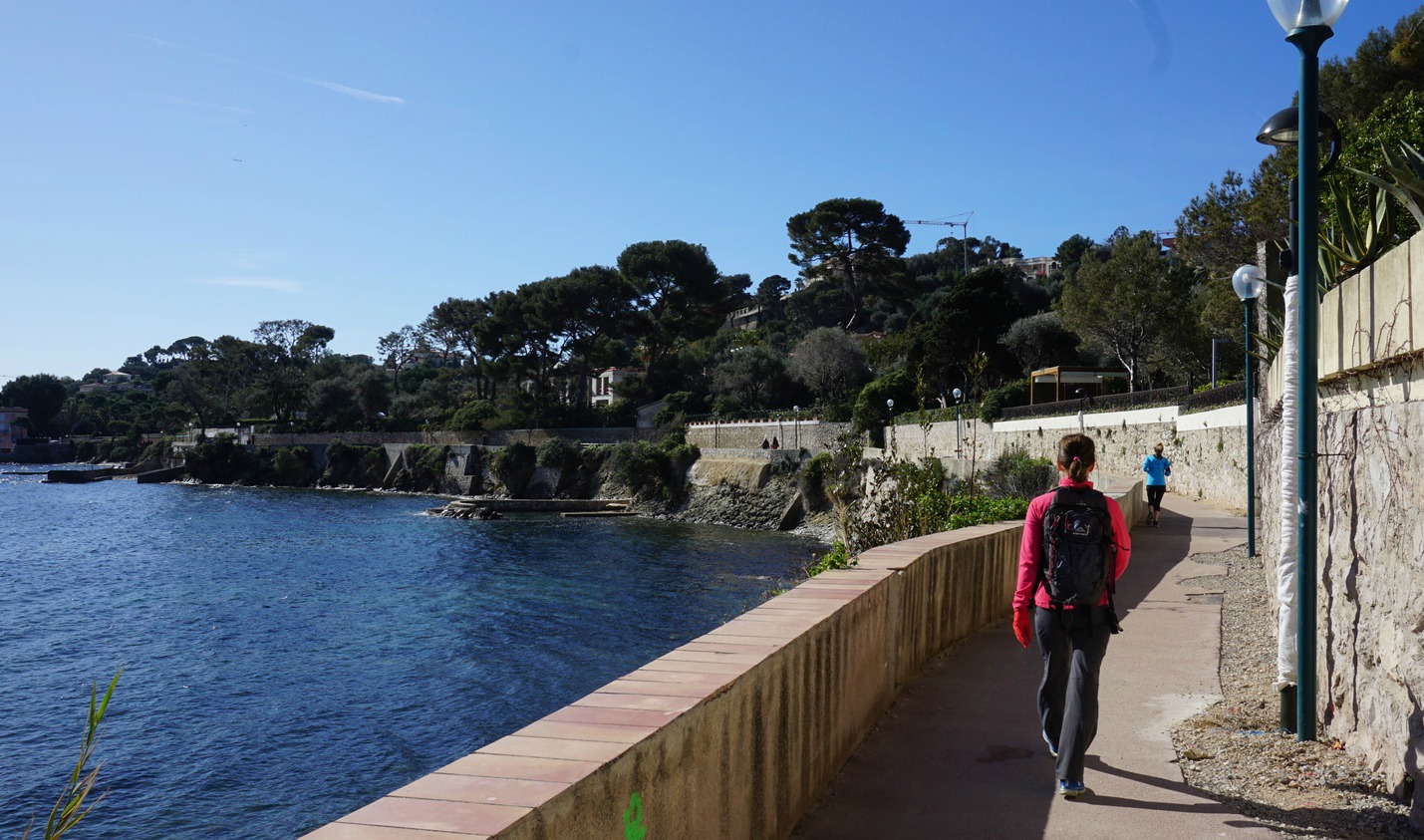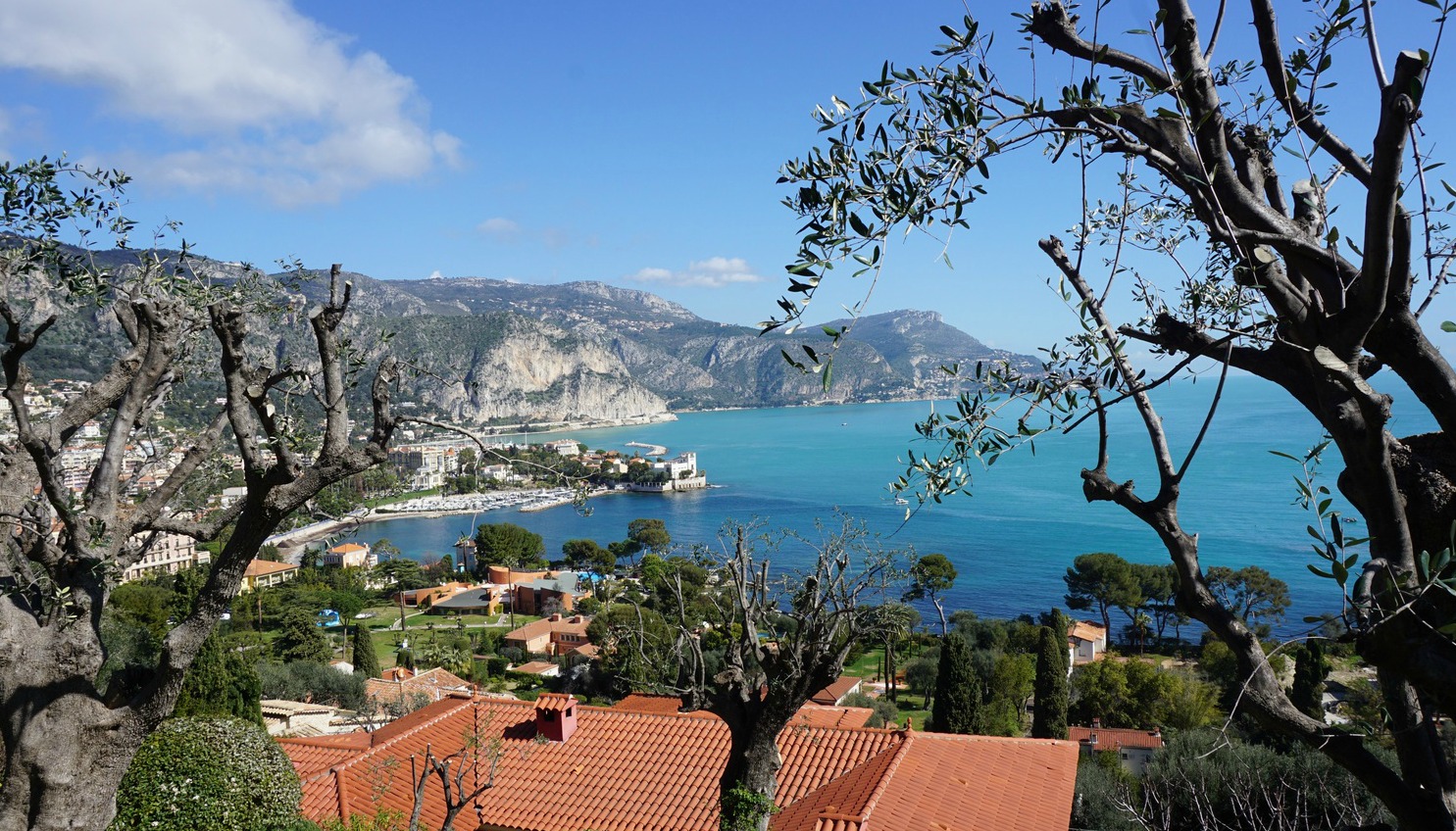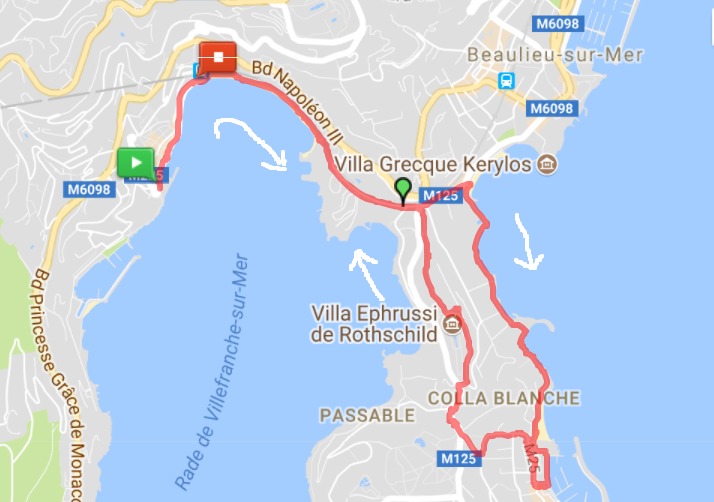

In spring, during the Monte Carlo Open Tennis tournament and Monaco Grand Prix, it is difficult to reach the Principality of Monaco by car, and to find a parking.
So why not park in La Turbie? The hiking trail down to Monaco is superb offering great views. We have done the hike a few times. The itinerary recommended by the randoxygène guide (called Trophée d’Auguste, starting from Monaco) makes a loop. It is a good option, partly following an ancient Roman trail, but runs more along paved streets. We decided to use the same trail both ways, staying more in the nature.
Leaving La Turbie (470 m), we walked through the old village along its narrow streets and came to the familiar signpost showing the way to Monaco, Cap d’Ail, and CNET on the top of Tête de Chien. We followed the trail (GR51B) that descended to a crossroads where we forked left down to Monaco.
We now descended more steeply following signposts down to Beausoleil and Monaco. We eventually reached a small yellow tower (a transformer) on a narrow but paved street. Here the new white and red GR signs advised to fork right (west) to Jardin Exotique. We vaguely remembered forking left towards the Monaco railway station at this point along Chemin de la Turbie Supérieur. This time, however, we decided to follow the newly painted GR signs. We soon reached Moyenne Corniche, crossed it, and found ourselves passing several not very nice construction sites, following temporary signs for pedestrians.
We eventually reached La Condamine neighbourhood near the harbour and took the stairs to the Rock and the old town of Monaco. We passed the Palace and headed to the U Cavanagio restaurant for lunch. It was just as enjoyable as before!
After lunch we decided to take the old trail from the railway station back to La Turbie. The trail still followed the same route as before: After passing through the railway station it ascended along the Avenue d’Alsace, then Chemin de La Turbie (stairs). No signs were visible until we reached the stairs, where we saw an old red and white GR sign.
We passed the yellow transformer tower again, and after that it was uneventful ascent back to La Turbie.
In short, we recommend taking the old, not very well marked trail down to the railway station thus avoiding the construction sites. It is a more tranquil route at the moment. The transformer tower by the road is the critical point (image)!
Incidentally, the French randoxygène guide (at least the on-line version) still describes the itinerary to and from the Monaco railway station whereas the map on the same page shows the new version to Jardin Exotique.
Duration: 3h30
Elevation gain: 580 m (includes detours en route plus the climb to the old town of Monaco)
Distance: About 11 km (includes detours and strolling in Monaco)
The upper image shows our itineray, the lower is our recommendation.
Map: 3742 OT “Nice-Menton” Côte d’Azur

I got inspiration for this recipe from an article in the French magazine ELLE about a young British chef who recently had opened a restaurant in Marseille. He told that he sometimes gets inspiration for his dishes while buying fresh fish from fishermen in the Vieux- Port.
For my recipe, I have used fresh fish and spring vegetables from our supermarket in Nice.
2 servings
For the lentil purée:
50 ml green lentils
1 spring onion, chopped
1 clove garlic, chopped
2 tbsp. olive oil
A bunch of parsley, minced
For the vegetables:
6 green asparagus
1 tbsp. olive oil
50 ml vegetable stock
100 ml fresh peas
Freshly ground black pepper
Zest and a few drops of juice from organic lemon
For the fish:
4 mackerels, filleted
1 tbsp. olive oil
1 tsp. piment d'Espelette or other mild chilli powder
Butter for the oven tray
Place the lentils in 250 ml water in a small casserole. Add the spring onion and garlic and bring to the boil. Reduce the heat, cover and cook for 30 minutes. Check now and again if you need to add a little water, it should be almost evaporated when the lentils are done. Set aside covered. Then purée with olive oil and parsley with hand- held mixer.
Wash and peel the asparagus. Cut into about 5 cm long pieces discarding the tough bottom part. Place in a large frying pan with olive oil and sauté over medium heat for 5 minutes. Add the peas and vegetable stock, cover and cook for about 3 minutes. Add the zest and a few drops of lemon juice and grind over some black pepper.
Meanwhile roast the mackerel fillets. Butter an ovenproof dish and place the mackerels in it skin- side up. Sprinkle the fillets with piment d'Espelette and olive oil and roast in 210° C for about 12 minutes depending on the size of the fish.
When the fish is done divide it on the plates. Place the lentil purée on the side, add the vegetables from the frying pan and decorate with some basil leaves.

The road north from Grasse is the famous Route Napoleon (RD 6085). The road was built in the 1930s to commemorate the emperor’s itinerary in March 1815 after his escape from Elba.
Today’s hike starts from the parking (about 550 m elev.) called Chêne de l’Empereur, the emperor’s oak, by the RD 6085. It is a hike along good paths offering panoramic views from its highest point down to Grasse, Pre du Lac, and the coast. The hike is described in the French Randoxygène guide. In autumn, the Marbrière forest is popular among hunters, and hikers are advised to stay on the trails.
From the parking we crossed the rather busy RD 6085 road and found the first signpost showing Tour de la Marbrière in front of the tennis courts. It is recommended to do the hike clockwise. The first part is also a part of the GR4 trail. The trail ascended gently in the woods, eventually merging with a wider forest track. We crossed the River Riocoucourge along a stone bridge and soon came to an intersection with a signpost. We forked right (east) leaving the GR4 and followed another dirt track (yellow markings).
We soon reached a plateau (895 m) and headed southeast leaving the dirt track. We continued a bit along a good path, then enjoyed our picnic in sunny albeit hazy April weather. We then descended rapidly to a wide forest track that also happened to be the GR51 trail. We followed it back to our starting point.
The French guide describes the hike as moyen, moderate, but the trail is quite easy, and the navigation did not pose any problems. The guide book’s duration is 3h 30 but we made it in 2h 30 at a moderate pace. It should be noted that there’s a network of trails in the mountains above Grasse making longer and custom-made tours possible.
Duration: 2 h 30
Elevation gain: 340 m (Own GPS data)
Distance: About 6 km
Map: TOP 25 No 3643 ET “Cannes-Grasse”

The French bakery industry is world famous. The global demand for its products is now increasing so much that last autumn the French TV news reported that the bakeries have problems obtaining enough butter! Luckily, I can still find pâte feuilletée, puff pastry, made with butter in our supermarket in Nice.
The following quiche recipe has a Greek twist because it is made with a generous amount of spinach and goat cheese or feta. I always choose pre-washed spinach in a bag for convenience. If you are good at baking, by all means make your own puff pastry from scratch.
4- 6 servings
A large bag, about 350g, pre-washed baby spinach leaves
3 eggs
200 g full-fat soft goat cheese or feta
2 tbsp. olive oil
2 shallots, chopped
2 cloves garlic, minced
Freshly ground black pepper
1 pâte feuilletée, ready- made puff pastry
Preheat the oven to 200-220°C (tart mode).
In a heavy casserole, cocotte, warm the olive oil over medium- low heat and fry the shallots and garlic for about 5- 10 minutes until softened. Add the spinach and continue cooking until the spinach is wilted. Set aside to cool and drain in a colander.
Roll out the puff pastry and line a 21- 22 cm quiche tin, moule à quiche. A non- stick loose based quiche tin guarantees easy removing.
In a large bowl, beat the eggs and black pepper. Cut the cheese into small pieces and add to the bowl. Add the drained spinach and mix.
Pour the mixture into the quiche tin and bake for about 30 minutes. Test the quiche with a wooden cocktail pick; it is done when the pick inserted near the centre comes out clean.
Let the quiche cool for a while. It is best served just warm, not hot, to bring out the flavours. A slice of quiche with some side salad makes a nice lunch. Any leftovers can be frozen.

Daube provençal is a classic South of France beef stew. The following version of veal, white wine, green olives, and fresh rosemary is a lighter spring stew. It is a typical French bistro dish. We recently had a similar stew in Paris this spring.
2 servings
2 tbsp. olive oil
About 400 g stewing veal, veau à mijoter
1 tbsp. flour
1 onion, coarsely chopped
1 clove garlic, minced
100 ml white wine
50 ml chicken stock
4 tomatoes, tomates en vigne
10 green olives
Freshly ground black pepper
2- 3 sprigs of fresh rosemary
Fresh parsley to decorate
Preheat the oven to 200° C.
If the stewing veal chunks are very large, cut them into smaller pieces about 3x3 cm.
Pour the olive oil in the bottom of a heavy casserole, such as Le Creuset. Place the meat in the casserole, add the flour, onion, garlic, black pepper, rosemary sprigs and stir.
Wash and coarsely chop the tomatoes. Add them to the casserole. Add the white wine, chicken stock and stir. The liquid does not need to wholly cover the meat and vegetables because spring tomatoes will yield some water. Transfer to the oven and roast for about 1 hour.
After 30 minutes, stir the stew.
When the stew is done, add the green olives. Divide on the plates, serve with new potatoes and decorate with parsley.
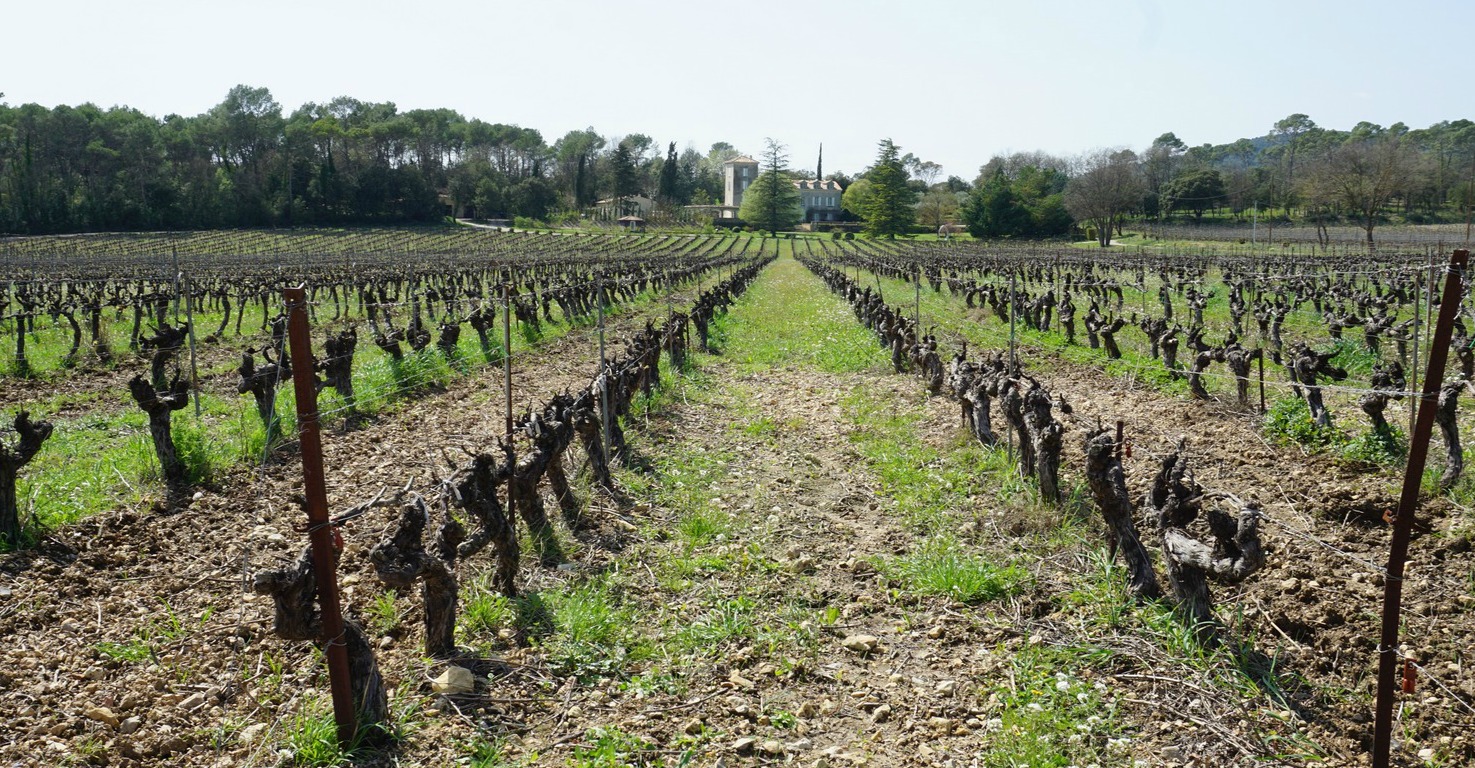
Our first stop was Château de Berne near Lorgues. We drove through Lorgues following signs to the Château. After a rather long drive along a narrow and winding road we suddenly saw the impressive domain in front of us. The domain has not only a vineyard, but also a 5-star spa hotel, a swimming pool, a bistro, a gourmet restaurant, and of course a wine shop. Various physical activities are offered. Their wine cellar produces 750000 bottles a year.
As many regions, including Paris, had school holidays, we had reserved a table in the bistro. The reservation was conveniently done online.
It was a warm and sunny spring day, and we were happy to sit outside. We all chose Formule de semaine which offered two choices of the first course and main course, then dessert or coffee. We opted for Caesar salad with giant shrimps followed by cod with red wine sauce and vegetables. Both dishes were exquisitely prepared and Berne’s rosé went very well with them.
After lunch we did some wine shopping. We have previously tasted their rosé which has always been fresh and fruity, but we were not so keen on their rectangular bottles. Luckily they had one rosé, Les Oliviers, in classic round bottles. It turned out to go very well with typical Provençal summer dishes back home, and at about 9€ per bottle was good value for money.
Our next stop was Château de Roubine between Lorgues and Draguignan. This 75-hectare vineyard has a long history; it has been known since 1307 when the Templar Knights sold it to the Order of St. John of Jerusalem. Later, various great Provençe families were the owners. From 1955, the Ministry of Agriculture awarded the title “Cru Classé” to the production of the domain. The vineyard is now owned by an ambitious couple making typically Provençal elegant wines. They export to 40 countries and have recently acquired the 50-hectare Ste Béatrice vineyard nearby. As a reminder of previously Monegasque ownership, many Ste Béatrice bottle labels continue to sport the coat of arms of Monaco.
It was easy to find their no-nonsense wine shop and vineyard by the D562 road. We were already familiar with their red Premium Cru Classé, about 15€ per bottle. As it is a bit hard to find in Nice, it was our natural choice.
We made a leisurely stroll in the vineyard following loosely the sentier vigneron, a footpath with information about their production, grape varieties etc. It was only us and the workmen in the vineyard bordered by pines, oaks, and the old castle surrounded by a garden.

Plan des Noves roughly 7 km north of Vence along the RD2 road is ancient farmland. Surrounded by hilltops, most of the plateau nowadays belongs to the Parc Naturel Départemental.
In spite of the modest elevation, this easy loop trail offers some great views towards the high mountains, the Baou St-Jeannet, and even a glimpse of the Mediterranean Sea.
The starting point is from the parking (780 m) of Plan des Noves by the RD2 road just before Col de Vence.
It was late March, but signs of spring were scarce. The weather during the last few weeks had been unusually cool and wet.
From the parking, we first followed the GR51 trail (white/red markings). Plan des Noves lies about 100 m below the starting point. The signposts marked the correct trail, showing the clockwise itinerary of Circuit du Plan des Noves. There were other paths and trails crisscrossing the plateau. At the first crossroads, we turned left (north), still following the GR51 a bit. After about 300 m, just before some ruins, we forked right leaving the GR trail and followed the trail with yellow markings. We crossed Plan des Noves heading southeast.
We then ascended a bit along a ridge with nice views to the east, notably to St-Jeannet and its Baou. We continued south, passing ruins of a stone hut, then to the west to a hill called Mangia Pan.
The trail now descended to the north, passing more ruins. We soon joined the GR51 again and ascended along it back to our starting point.
Duration: 2 h hiking time
Climb: 240 m
Distance: 7,5 km
Map: “Cannes-Grasse” Côte d’Azur 3643 ET
The image shows our GPS trail. The Randoxygène guide (in French) has a description of this hike, too.

I got the inspiration for this recipe from one of Martin Walker’s Bruno Chief of Police books. Bruno baked a whole salmon of three kilos wrapped in foil and flavoured with herb paste.
The following recipe is my twist of Bruno’s salmon. I have replaced the salmon with portion size trout and tarragon with dill. The recipe is glutenfree.
2 servings
2 portion size trout
½ organic lemon
2 tsp. Dijon mustard
For the herb paste:
Zest of ½ organic lemon
1 clove garlic, minced
2 tbsp. finely chopped parsley
2 tbsp. finely chopped dill
A pinch of salt
Freshly ground black pepper
4 tbsp. olive oil
Preheat the oven to 180° C.
Mix the herb paste. Then peel the lemon half and thinly slice it. Arrange the lemon slices inside the trout.
With a sharp knife, make deep slashes into the sides of the trout and stuff some herb paste into each slash. Stuff some herb paste inside the trout. Thinly coat the trout with Dijon mustard and spread the remaining herb paste on top.
Wrap the trout in foil and bake on a rack for 15- 20 minutes.
Serve the fish with wilted spinach or steamed asparagus and new potatoes or quinoa. The herb-
lemon flavoured olive oil when you open the foil will give a nice sauce.

Here in the South of France, endives are true winter vegetables. The following recipe, endives and mushrooms with chicken breast, is my twist of a recipe in Nice-Matin many years ago. Endives and mushrooms go just as well with pork or veal chops as with chicken breast.
2 servings
2 organic chicken breasts
2 tsp. pistou (purée of basil leaves, salt and olive oil)
2 nice endives
About 10 mushrooms, champignons de Paris, sliced
1 shallot, chopped
1 clove garlic, minced
3 tbsp. olive oil
4 tbsp. crème fraîche
150 ml white wine
butter
Black pepper
Parsley to decorate
Preheat the oven to 180°C.
Remove the outer layers from the endives and tail them. Microwave for 2- 3 minutes and dry with kitchen paper. Warm 1 tbsp. olive oil in a small frying pan over medium heat and fry the endives on both sides until golden. Transfer to a small buttered oven proof dish and cover with crème fraîche. Bake for 30 minutes in the oven; the crème fraîche reaches the texture of sauce béchamel. NB! Low fat crème fraîche does not work this way in the oven.
Meanwhile cook the mushrooms, chicken breasts and some brown rice.
In a frying pan warm 2 tbsp. olive oil over medium heat and start sautéing the sliced mushrooms. Sauté the chicken breasts over medium heat in the same pan that you used for the endives. First make a small pocket in the chicken breasts and fill with pistou. Then sauté on both sides until nicely coloured. Pour 50 ml white wine in the pan, cover and let simmer.
Add the chopped shallot and minced garlic to the pan with mushrooms. Continue sautéing for 10 minutes stirring occasionally. Then add the black pepper and remaining 100 ml white wine, cover and simmer at a very low heat.
Remove the endives from the oven to a warm plate. Pour the remaining crème fraîche from the oven proof dish into the pan with mushrooms and stir, you should have a creamy sauce in the pan.
Open the endives with a small knife and divide on the plates. Divide the chicken breasts and brown rice on the plates. Pour the mushroom- crème fraîche sauce over the endives and chicken breasts and decorate with parsley.
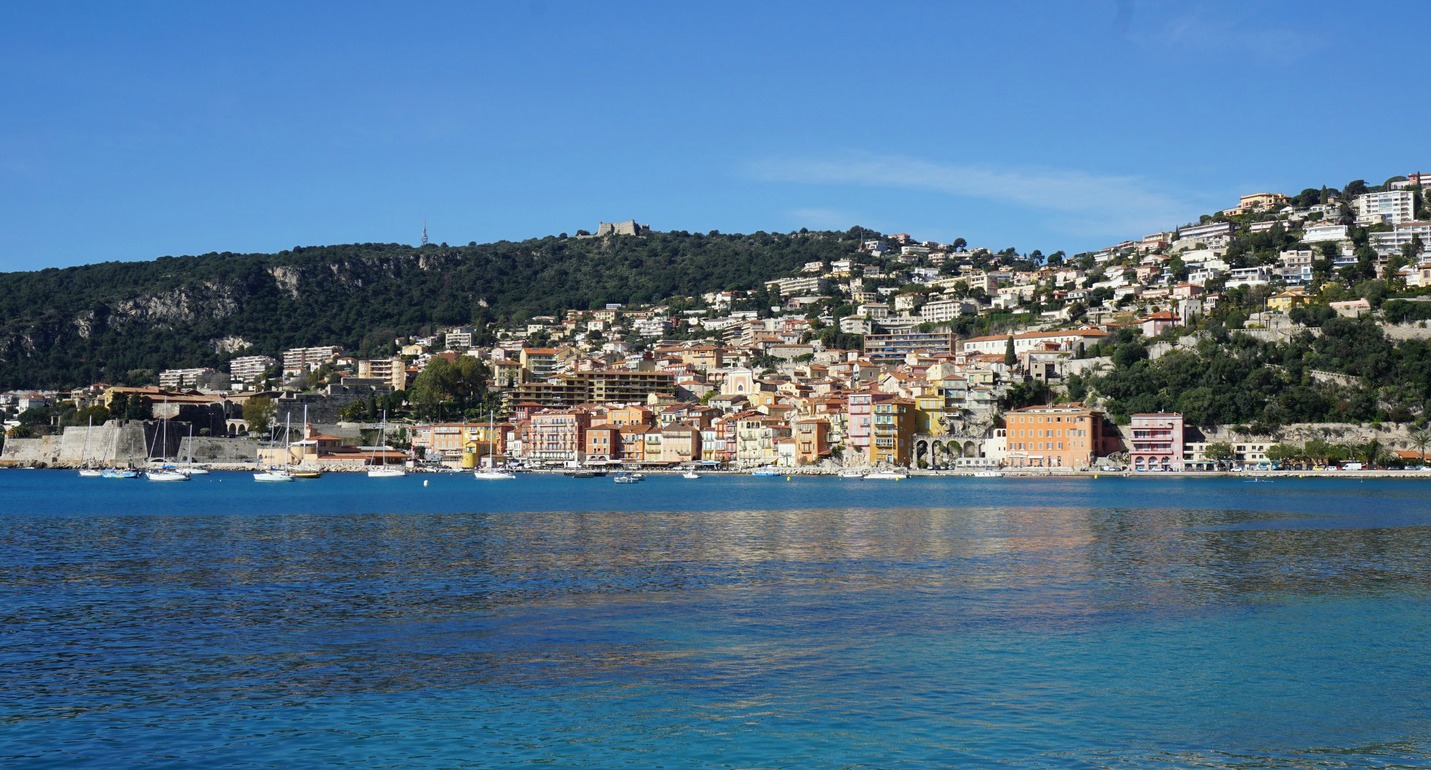
We started our walk from the harbour of Villefranche-sur-Mer, which is easily reached following the Basse Corniche (RM 6098). In the harbour there’s a spacious toll parking.
It is always a pleasure to walk along the Plage des Marinières, admiring the beauty of the location. On a sunny day, you never get tired of the views!
At the end of the beach, we took the stairs to elegant Av. Louise Bordes. After the crossroads we continued towards Beaulieu-sur-Mer and soon reached Plage des Fourmis. After briefly admiring Villa Kerylos on the other side of the bay, we took the Promenade Rouvier. This excellent and mostly paved path links Beaulieu-sur-Mer with Saint-Jean-Cap-Ferrat.
At the harbour of Saint-Jean, we took stairs to the terrace above. We saw that a lot of renovation work had recently been done there, with some new restaurants and cafes.
Our itinerary continued along Avenue Denis Séméria that ascended from the harbour, eventually passing the tourist office. At this point, it is best to stay on the left side where the pavement is continuous. After about 150 m, we crossed the rather busy main street and walked past the entrance of Villa Ephrussi de Rothschild.After 200-300 m, we forked left taking the stairs up to the top of the isthmus. The panoramic alley on the isthmus was called Chemin des Moulins. We followed it straight north and came to the main road and intersection (pont St-Jean) soon enough. From here, we walked back to our starting point.
Cruise ships frequently call at Villefranche-sur-Mer. This walk would be ideal for travellers who have not booked a shore excursion and wish to explore the area by themselves: A morning walk followed by lunch in the harbour or on board the ship!
Duration: 2 h
Distance: 8,1 km
Elevation gain: 85 m







